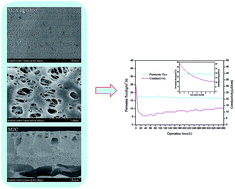Interconnected PVDF-CTFE hydrophobic membranes for MD desalination: effect of PEGs on phase inversion process†
Abstract
In this work, poly(vinylidene fluoride-co-chlorotrifluoroethylene) (PVDF-CTFE) was used for hydrophobic membrane preparation by the non-solvent induced phase inversion (NIPS) technique. The effects of poly(ethylene glycol) (PEG) molecular weight and dosage were investigated in terms of the membrane morphology, contact angle, surface free energy, and membrane pore structure for both surface pores and overall pores. All membranes possessed a typical liquid–liquid demixing asymmetric structure and the contact angles were higher than 85°. Furthermore, increasing the PEG molecular weight and dosage significantly altered the membrane pore structure and surface roughness as a result of the variation of the phase inversion process. The solid–liquid demixing was responsible for the variation of membrane morphology, pore structure, hydrophobicity, and DCMD performance as PEGs with higher molecular weight or dosage were added. The PVDF-CTFE membranes were suitable for MD application owing to their high hydrophobicity, small pore size with narrow pore distribution, high DCMD performance, especially the interconnected pore structure. The membrane containing 5 wt% PEG-400 was evidenced to be the optimal one for the MD process, mainly according to the high interconnected pore structure which provide more passages for vapour transfer. The permeate flux was 17.98 kg (m−2 h−1) with a conductivity as low as 7 μS cm−1 at the temperature difference of 30 °C. In addition, an excellent performance sustainability was observed including a relatively steady permeate flux and conductivity during the 360 h continuous DCMD operation.


 Please wait while we load your content...
Please wait while we load your content...